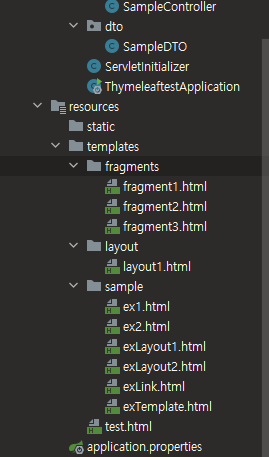Notice
Recent Posts
Recent Comments
Link
| 일 | 월 | 화 | 수 | 목 | 금 | 토 |
|---|---|---|---|---|---|---|
| 1 | ||||||
| 2 | 3 | 4 | 5 | 6 | 7 | 8 |
| 9 | 10 | 11 | 12 | 13 | 14 | 15 |
| 16 | 17 | 18 | 19 | 20 | 21 | 22 |
| 23 | 24 | 25 | 26 | 27 | 28 | 29 |
| 30 |
Tags
- 숫자정렬
- 자바알고리즘
- 버블정렬
- GUI
- 자바GUI
- 이클립스 #이클립스단축키 #자바 #자바단축키
- Spring
- 계산기
- 오름차순정렬
- 자바
- 자바 계산기
- 버블소트
- annotation
- 계산기GUI
- Swing
- 알고리즘
- Java
- 어노테이션
- 배열정렬
- Eclipse
- MVC
- 자바 #java #이클립스 #eclipse #switch #switch문 #사칙연산 #계산기 #calculator #간단한계산기
- 이클립스
- 스프링
- 내림차순정렬
Archives
- Today
- Total
온 코딩
[Spring Boot- Thymeleaf] 레이아웃 짜는 법 - Bootstrap 본문
타임리프 레이아웃 방법
1. JSP의 include와 같이 특정 부분을 가져와서 포함 시키는 형태
- th:insert : th:~~의 바깥쪽태그는 유지하면서 태그의 시작과 끝 내부에 삽입하는 방식
- th:replace : 기존 내용을 대체하는 방식
포함되는 HTML
th:fragment : 포함하는 HTML에서 사용할 이름
2. 특정부분을 파라미터 형태로 전달하여 내용에 포함하는 형태
th:fragment
그외
th:block : HTML의 <div></div>역할을 하는 Thymeleaf 지원 태그
* 기존 버전에는 th:include가 있었지만 3.0버전 이후로는 사라짐!
1. include 방식
SampleController에 요청 메서드 추가
프로젝트 구조
포함되는 HTML : template/fragment/fragment1.html and fragment2.html
포함하는 HTML : template/sample/exLayout.html
스타일, 링크, 메타 태그 등은 절대 포함되는 파일에 사용하면 안 됨 ! -> 레이아웃 태그이기 때문

*Controller 구조
package com.example.thymeleaftest.controller;
import com.example.thymeleaftest.dto.SampleDTO;
import lombok.extern.log4j.Log4j2;
import org.springframework.stereotype.Controller;
import org.springframework.ui.Model;
import org.springframework.web.bind.annotation.GetMapping;
import org.springframework.web.bind.annotation.RequestMapping;
import java.time.LocalDateTime;
import java.util.List;
import java.util.stream.Collectors;
import java.util.stream.IntStream;
@Controller
@RequestMapping("/sample")
@Log4j2
public class SampleController {
@GetMapping("/ex1")
public void ex1(){
log.info("되냐 안되냐 졸지 말고 수업들어!~!!!!");
}
//외부로부터 Model 객체를 전달받아 Model 객체에 20개의 DTO객체를 담아 ex2.html로 전달
//Model 객체는 Spring Boot가 자동으로 생성하여 전달하기 때문에 개발자는 별도 작업이 필요없다
@GetMapping({"/ex2", "/exLink"}) //다중 url 설정이 가능
public void exModel(Model model){
List<SampleDTO> list = IntStream.rangeClosed(1,20).asLongStream().mapToObj(i ->{
SampleDTO dto = SampleDTO.builder().sno(i).first("first "+i).last("/last "+i).regTime(LocalDateTime.now()).build();
return dto;
}).collect(Collectors.toList());
model.addAttribute("list",list);
}
//레이아웃을 위한 추가 메서드
@GetMapping({"/exLayout1","/exLayout2"})
public void exLayout(){
log.info("exLayout~~!!");
}
}
1. insert와 replace차이
<!DOCTYPE html>
<html lang="en" xmlns:th="http://www.thymeleaf.org">
<head>
<meta charset="UTF-8">
<title>fragment1.html</title>
</head>
<body>
<div th:fragment="part1"> <!--th:fragment="part1"을 exLayout1.html에서 사용할 이름을 지정 -->
<h2>Part1</h2>
</div>
<div th:fragment="part2">
<h2>Part2</h2>
</div>
<div th:fragment="part3">
<h2>Part3</h2>
</div>
</body>
</html><!-- fragment2.html : 전체가 include 되는 페이지이므로 기본 구조 불필요-->
<div>
<hr/>
<h2>Fragment 2 File</h2>
<h2>Fragment 2 File</h2>
<h2>Fragment 2 File</h2>
</div><!DOCTYPE html>
<html lang="en" xmlns:th="http://www.thymeleaf.org">
<head>
<meta charset="UTF-8">
<title>exLayout1.html</title>
</head>
<body>
<h1>Fragment Test</h1>
<div >
<th:block th:replace="~{/fragments/fragment2}"></th:block>
<!--th:block == div-->
<!--th:replace="~{/경로/파일명}" 해당 파일 전체가 포함됨 // 포함되는 파일에 기본 태그 있으면 안됨 -->
</div>
<hr/>
<h1>Layout 1-1</h1>
<div >
<div th:replace="~{/fragments/fragment1 :: part1}"></div>
<!--th:replace="~{/fragment/fragment1 :: part1} 해당 이름을 가진 부분만 포함된다 // 대체 -->
</div>
<hr/>
<h1>Layout 1-2</h1>
<div >
<div th:insert="~{/fragments/fragment1 :: part2}"></div>
<!-- 여기에 삽입 ~{/fragment/fragment1 :: part2}가 삽입 됨 -->
</div>
<hr/>
<h1>Layout 1-3</h1>
<div >
<div th:replace="~{/fragments/fragment1 :: part3}"></div>
</div>
<hr/>
</body>
</html>
1. replace 진행 확인
<!DOCTYPE html>
<html lang="en">
<head>
<meta charset="UTF-8">
<title>fragment3</title>
</head>
<body>
<div th:fragment="target(first,second)">
<style>
.c1{background-color: pink}
.c2{background-color: aquamarine}
</style>
<div class="c1">
<th:block th:replace="${first}"></th:block>
</div>
<div class="c2">
<th:block th:replace="${second}"></th:block>
</div>
</div>
</body>
</html><!DOCTYPE html>
<html lang="en" xmlns:th="http://www.thymeleaf.org">
<head>
<meta charset="UTF-8">
<title>exLayout2.html</title>
</head>
<body>
<div th:replace="~{/fragments/fragment3 :: target(~{this::#ulFirst},~{this::#ulSecond})}">
<ul id="ulFirst">
<li>AAA</li>
<li>AAA</li>
<li>AAA</li>
</ul>
<ul id="ulSecond">
<li>BBB</li>
<li>BBB</li>
<li>BBB</li>
</ul>
</div>
</body>
</html>3. th:fragment 태그 활용
<!DOCTYPE html>
<html lang="en" xmlns:th="http://www.thymeleaf.org">
<th:block th:fragment="setContent(content)">
<head>
<meta charset="UTF-8">
<title>layout1</title>
</head>
<body>
<style>
*{margin: 0; padding: 0;}
.header{width:100vw; height: 20vh; background-color: aquamarine}
.content{width:100vw; height: 70vh; background-color: darkorange}
.footer{width:100vw; height: 10vh; background-color: darksalmon}
</style>
<div class="header">
<h1>HEADER</h1>
</div>
<div class="content">
<div th:replace= "${content}">
</div>
</div>
<div class="footer">
<h2>FOOTER</h2>
</div>
</th:block>
</body>
</html><!DOCTYPE html>
<html lang="en" xmlns:th="http://www.thymeleaf.org">
<th:block th:replace="~{/layout/layout1 :: setContent(~{this::content})}">
<th:block th:fragment="content">
<h1>exTemplate page</h1>
콘텐츠 세부 내용
</th:block>
</th:block>'복습 ARCHIVE > 모델별 프로젝트' 카테고리의 다른 글
| [Spring Security] - Spring Secrete, Spring Security, sts (0) | 2021.07.19 |
|---|---|
| [Spring Boot] JPQL과 SQL / Query Annotation / Querydsl (0) | 2021.07.16 |
| [Spring boot](Spring starter JPA) Thymeleaf 시작 th: 태그모음 (0) | 2021.07.08 |
| [Spring Boot](Spring Data JPA) memoTest - IntelliJ2 (0) | 2021.07.08 |
| [Spring Data JPA] memoTest - IntelliJ (0) | 2021.07.07 |
Comments


